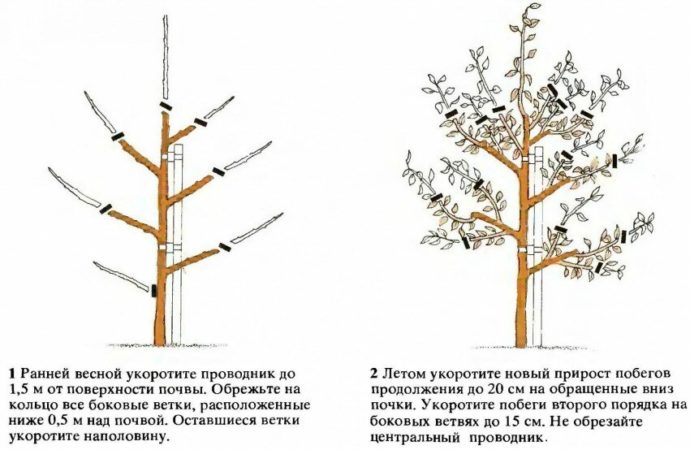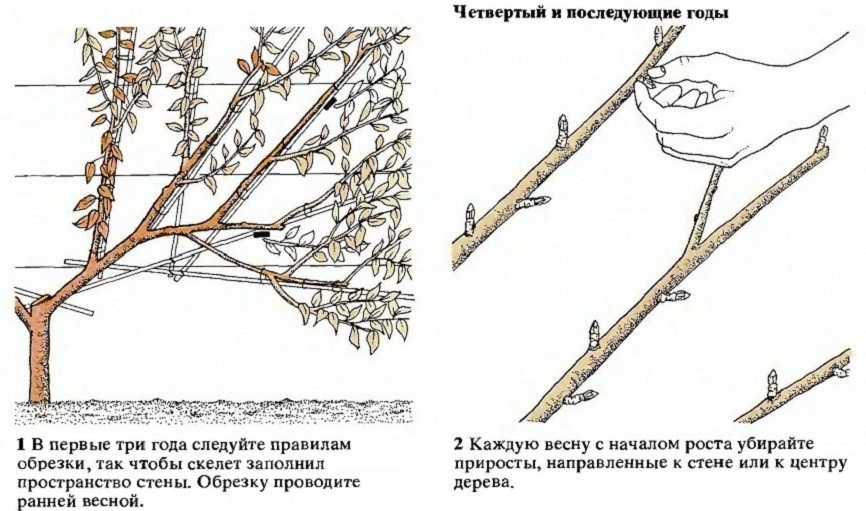Step-by-step instructions for pruning plums in the summer with your own hands
To obtain a healthy, abundantly fruitful tree from a plum sapling, it is important to prune so that the crown forms correctly. Many gardeners perform the procedure in the spring, giving the plant more time to recover before the winter frosts. Consider whether it is advisable to form the crown in the summer, if you did not manage to do it in the spring.
The content of the article
Is it possible to prune plums in summer
Pruning is carried out at any time of the year, except for winter. This is done to keep the tree healthy and fruitful.
Too dense crown impedes the proper development of the plant, it becomes more vulnerable to winter cold and prone to diseases during the growing season.
In each of the seasons, including summer, when pruning, specific goals and objectives are solved.

Summer pruning targets
The summer haircut, which takes place in June and July, is only suitable for young seedlings. At this time, branches frozen in winter are removed, which were not found during the spring procedure. The places where the crown is too thick and there are more branches become more noticeable. Such shoots are thinned and shortened.
The procedure is carried out from 2 years of age of the plant, and adult trees are cut off only when absolutely necessary.
Is it obligatory
Formation and pruning in the summer are mandatory for young plants, they allow you to achieve the following positive results:
- increasing frost resistance and reducing the risk of branches breaking under the weight of accumulated snow;
- elimination of excessive thickening of the crown, which will give the plant enough heat and light, increase productivity;
- growth of branches in the right direction and a well-formed crown, which simplifies harvesting.
Pruning in June helps the tree prepare for fruiting. It protects against diseases and promotes the ripening of a bountiful harvest.
Timing
The timing of the procedure depends on the climatic zone, weather, age and general condition of the plant. The milder the weather conditions, the later the pruning is done.
Reference. In the Moscow region, the haircut is completed in July, and in the Krasnodar Territory, where the temperature in winter rarely drops below 0 ° C, in late summer and even early autumn.
Mature trees are pruned from early June to July, young plants - 20-30 days before the start of the growing season.
Types of trimming
Gardeners use several types of pruning:
- Formative - to create the shape of the aerial part of the plant. It increases the resistance to stress and longevity of the tree.
- Regulating - to access the branches of light and heat.
- Anti-aging - for the formation of new shoots, stimulation of the development of dormant and adventitious buds.
- Restorative - to renew the functions of growth and fruiting.
- Sanitary - for removing sick, damaged and dried branches.
Pruning plums in summer has a formative and sanitary value, affects the size of the future harvest, protects against diseases and increases the life of the tree.
How to prune a tree correctly

The first time the plant is formed when planting. This procedure is carried out until the plant reaches approximately 15 years of age.
Important! Vertical branches do not bring crops, they are disposed of first.
Further, only sanitary pruning is performed for high-quality and long-term fruiting.
Tools and materials
For novice gardeners, this procedure is difficult and responsible.In order not to harm the plant, it is important to carry out it according to the established scheme using well-sharpened, processed tools and high-quality materials. Old and dull blades can damage the plant.
For work you will need:
- secateurs;
- lopper with long handles;
- garden saw;
- knife;
- a special solution or self-prepared garden pitch for treating damage.
The cut should be smooth and neat, without burrs and irregularities. After the completion of the work, it is treated with a special solution (for example, brilliant green, RanNet paste) or with a self-prepared garden varnish.
To do this, mix 50 g of rosin and wax, 200 g of fat or vegetable oil, boil for 30 minutes until dissolved. The resulting mass is mixed and poured into a storage container.
All cut branches damaged by fungus or insects are burned to prevent reinfection.
Pruning schemes

In summer, the plum is formed according to the following scheme:
- The main trunk of young medium-sized plants is shortened by 12-15 cm. In higher varieties, it is left no more than 2 m in height.
- Remove 2/3 of lateral branches by pinching over 5–7 leaves.
- Cut off vertical fattening shoots located on the trunk or inside the tree. As a result, the nutrition of the fruiting branches is enhanced and their illumination improves.
- Remove damaged, diseased, dry and frozen shoots, with signs of disease and affected by the fungus.
- Shoots without fruit are harvested.
- At the end of June, the branches are cut to the ring.
- The emerging root growth is removed. This will increase the yield of the plant.
The purpose of the procedure is one - to stimulate the plant to further growth. Therefore, with a sufficient growth of 40-50 cm, pruning is not necessary, you can limit yourself to removing diseased and dry branches.
If the growth is weak, you will have to carry out a haircut:
- Bud pruning is done when it is required to change the direction of growth of a branch. To do this, a bud is found on a young shoot, located in the direction of pruning. The shoot is removed at a slight angle so as not to damage the kidney and leave a stump over it.
- Shortening by a ring is performed when a diseased or improperly growing powerful branch is cut. It is removed with a pruning shears to the base at an angle along the outer edge of the ring from the influx of bark.
- Pruning to a lateral branch is carried out when only one of several shoots is left, so that it becomes a continuation of the main branch, and the growth spreads to it.
Features of pruning plum
Not all trees are cut and shaped in the same way. The procedure varies depending on the age of the plant or the growing region.
An adult plant is pruned in the summer, from early June to July. It is better to form young plants at an earlier date, in spring, so that they get stronger before winter arrives.
In Siberia, in the Urals and in the middle lane, pruning is carried out in the spring and summer, so that the cuts can be tightened before the winter frosts and the plant does not die. In the southern regions, the procedure is carried out even at the beginning of autumn.
Further care of the plant
After pruning, the tree needs careful maintenance:
- in hot weather, he needs frequent watering: 3-5 times per season, 3 buckets of water per 1 m² of the trunk circle;
- support the plant with nitrogen during the period of fruit set, potassium and phosphorus - after harvest, as well as weeding and weed control;
- in summer there are no severe frosts, but the soil around the trunk should be loose and mulched, for which sawdust or straw are used.
The tree must have time to receive all the nutrients for abundant fruiting and prepare for future wintering.
Experienced gardening tips
To grow a healthy, well-formed tree that will yield a rich harvest, gardeners recommend:
- Carry out minimal pruning after the first fruiting without removing healthy branches and thinning the crown.
- In the middle lane and northern latitudes, remove diseased and weakened shoots in spring and summer, so as not to injure the culture before the winter cold. If you carry out the procedure too sooner or later, fruiting will decrease, the seedling may die.
- Form the crown of a young plant in the form of a bowl. This form is most favorable for the development and growth of the plant and helps to increase yields.
- Pruning is carried out strictly according to the schemes. After that, be sure to feed the plant, loosen and mulch the soil.
- Process plant sections immediately to prevent fungal infection.
- Store garden tools in a dry place without moisture and condensation.
- Lubricate tools regularly to prevent rust. Rusty and dull inventory cannot be used.
- Pre-disinfect cutting surfaces with alcohol or a solution of potassium permanganate.
It is interesting:
Conclusion
Competent and timely pruning of plums increases its yield, prolongs the period of active fruiting and lifespan, protects against diseases.
In order for the tree to fully recover before winter frosts, the procedure is carried out in the spring, but shaping and sanitary haircuts are performed in the summer. In this case, it is important to strictly follow the pruning schemes and properly care for the plant after.